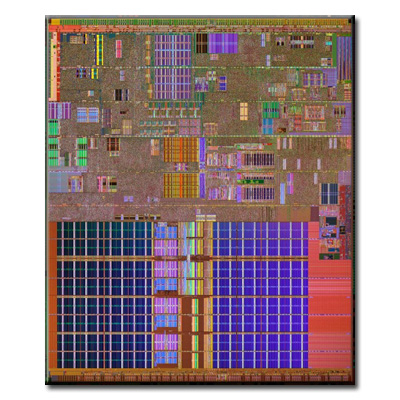Intel Pentium 4 (Prescott 2M) processors
Introduction: February 2005
Overview
The Pentium 4 brand refered to Intel's line of single-core mainstream desktop and laptop central processing units (CPUs) introduced on November 20, 2000 (August 8, 2008 was the date of last shipments of Pentium 4s). They had the 7th-generation architecture, called NetBurst, which was the company's first all-new design since 1995, when the Intel P6 architecture of the Pentium Pro CPUs had been introduced. NetBurst differed from the preceding Intel P6 - of Pentium III, II, etc. - by featuring a very deep instruction pipeline to achieve very high clock speeds (up to 4GHz) limited only by max. power consumption (TDP) reaching up to 115W in 3.6–3.8GHz Prescotts and Prescotts 2M (a high TDP required an additional cooling that was noisy or expensive). In 2004, the initial 32-bit x86 instruction set of the Pentium 4 microprocessors was extended by the 64-bit x86-64 set.
Pentium 4 CPUs introduced the SSE2 and SSE3 instruction sets to accelerate calculations, transactions, media processing, 3D graphics, and games. They also integrated Hyper-threading (HT), a feature to make one physical CPU work as two logical and virtual CPUs. The Intel's flagship Pentium 4 also came in a low-end version branded Celeron (often referred to as Celeron 4), and a high-end derivative, Xeon, intended for multiprocessor servers and workstations.
The Pentium 4 had an IHS (Integrated Heat Spreader) that prevented the CPU core from accidentally getting damaged when mounting and unmounting cooling solutions. Prior to the IHS, a CPU shim was sometimes used by people worried about damaging the core. Overclockers sometimes removed the IHS on Socket 478 chips to allow for more direct heat transfer. However, on LGA775 chips the IHS was directly welded to the processor core, meaning that the IHS cannot be removed without irreparably damaging the processor.
In 2005, the Pentium 4 was superseded by the Pentium D and Pentium Extreme Edition dual-core CPUs.
The Prescott 2M core
Intel, by the first quarter of 2005, released a new Prescott core with 6x0 numbering, codenamed "Prescott-2M". Prescott-2M was also sometimes known by the name of its Xeon derivative, "Irwindale". It featured Intel 64, the XD Bit, EIST (Enhanced Intel SpeedStep Technology), Tm2 (for processors at 3.6GHz and above), and 2MB of L2 cache. However, any advantage introduced by the added cache was mostly negated due to higher cache latency, and the double word size if using Intel 64 mode. Rather than being a targeted speed boost, the double size cache was intended to provide the same space and hence performance for 64-bit mode operations.
6xx series Prescott-2Ms had incorporated Hyper-Threading in order to speed up some processes that use multithreaded software, such as video editing.
On 14 November 2005, Intel released Prescott-2M processors with VT (Virtualization Technology, codenamed "Vanderpool") enabled. Intel only released two models of this Prescott-2M category: 662 and 672, running at 3.6 and 3.8GHz, respectively.
Source: Wikipedia, the free encyclopedia.



